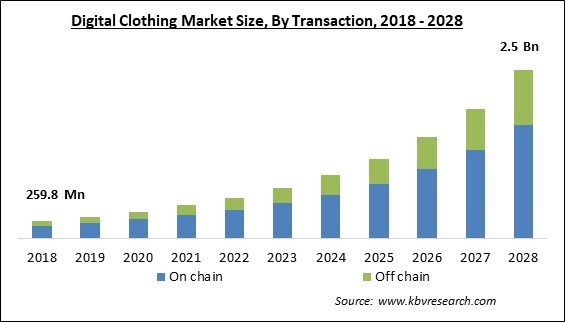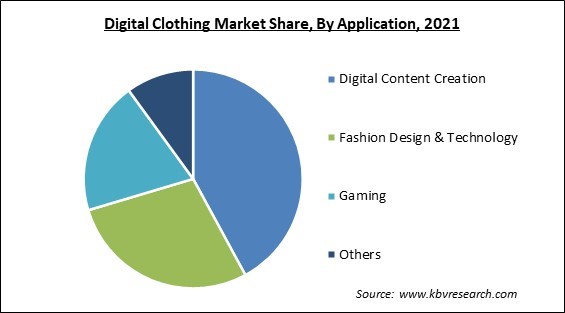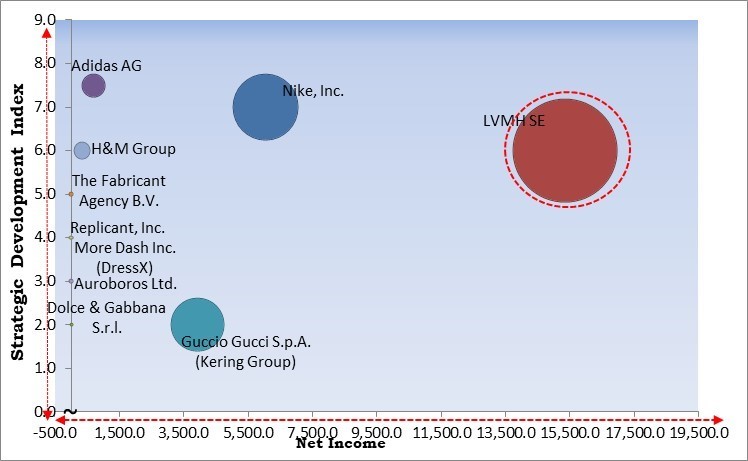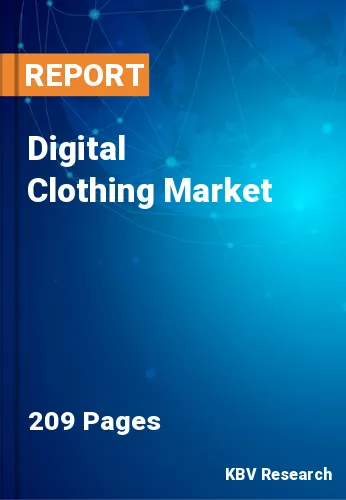The Global Digital Clothing Market size is expected to reach $2.5 billion by 2028, rising at a market growth of 26.6% CAGR during the forecast period.
Digital clothing is made of no tangible things, including fabric, and is a computer-generated image designed to closely imitate original real-world clothing. These garments use 3D modeling software and computer technology rather than materials. To produce, displaying, and assess the qualities of clothing in a virtual environment are the objectives of digital fashion designers.

In addition to using specific software and tools, digital fashion design requires understanding materials science, ergonomics, production technology, and anthropometric measurements. The field of digital fashion has recently emerged from obscurity to become one that is expanding quickly. The rise in the metaverse's development and the rising demand for eco-friendly clothes are predicted to contribute to the digital clothing market's significant growth over the forecast period.
For people who tend to wear an outfit only once for a social media platform, digital clothing offers an alternative. A digital wardrobe might be more environmentally friendly than purchasing an outfit and supporting the fast fashion obsession.
The fact that social media has created an online atmosphere that promotes the display of clothing and fashion from perhaps immoral companies speaks volumes about what a particular culture value today. Social media culture heavily emphasizes maintaining one's appearance, but it's important to consider how this may affect e-commerce and the environment.
Even anything as straightforward as moving from paper to digital or starting an online store might be considered a digital transformation. COVID-19 substantially expedited this change in the fashion sector by ten times while also normalizing and democratizing the concept of becoming digital. Additionally, businesses might employ this digital clothing to create gaming consoles and online fashion weeks, opening up the lucrative potential for developing the digital clothing market. Thus, the outbreak of COVID-19 has benefited the digital clothing market.
The metaverse will be the finest place for digital fashion to leave its mark. One of the technologies that will be a foundational element of the metaverse is digital fashion, which has numerous positive environmental effects. Moreover, developing digital clothing in the form of NFT wearables will promote true ownership. The metaverse is more than just a setting for video games and wandering. It is a virtual reality environment where actual physical events can take place. Therefore, the expansion of the digital clothing market is fueled by such metaverse platform advancements.
The fashion industry contributes significantly to annual worldwide carbon emissions and is extremely environmentally harmful. The pollution caused by such astonishing figures is equivalent to all emissions from international airplanes and maritime shipping. Moreover, until now, the production of all textiles has had a significant negative influence on the environment because many of them are discarded each year and either burnt or dumped in landfills. These aspects are leading to market growth in the upcoming years.
Cyber-physical attacks are among the greatest security issues in the Metaverse. This is where an adversary could take control of physical systems using cyber methods. This could involve taking control of a player's avatar to hurt or modify their environment. The denial of service (DoS) attack is a key security and privacy concern for the Metaverse. It's an attack that aims to render a service or network inaccessible by overwhelming traffic or resource demands. DoS assaults often target servers or high-profile targets.
Based on technology, the digital clothing market is segmented into 3D software, blockchain, artificial intelligence and others. The 3D software segment covered a considerable revenue share in the digital clothing market in 2021. Professional fashion designers find 3D to be quite fascinating. Designers must utilize 3D modeling software to develop the clothing and accessories they wish to prototype or produce to take full advantage of this technology. Due to the rendering and visualization capabilities of these 3D programs, the fashion industry is particularly interested in these topics.
On the basis of transaction, the digital clothing market is divided into on chain and off chain. In 2021, the on-chain segment witnessed the largest revenue share in the digital clothing market. The transactions updating the worldwide blockchain network are considered on-chain transactions because they've been legally validated or authenticated. Furthermore, since they are timestamped and replicated throughout the blockchain network, on-chain transactions are visible and safe.
By application, the digital clothing market is classified into digital content creation, fashion design & technology, gaming and others. In 2021, the digital content creation segment dominated the digital clothing market with the maximum revenue share. Digital content creation involves generating ideas and collecting information from mainstream media for specialized purposes. Audio or video files, text, pictures, and graphics are examples of digital content creation. In addition, it allows the company to connect with website visitors, which promotes the brand's scalability and increases the need for content creation.

| Report Attribute | Details |
|---|---|
| Market size value in 2021 | USD 487.8 Million |
| Market size forecast in 2028 | USD 2.5 Billion |
| Base Year | 2021 |
| Historical Period | 2018 to 2020 |
| Forecast Period | 2022 to 2028 |
| Revenue Growth Rate | CAGR of 26.6% from 2022 to 2028 |
| Number of Pages | 209 |
| Number of Table | 364 |
| Report coverage | Market Trends, Revenue Estimation and Forecast, Segmentation Analysis, Regional and Country Breakdown, Competitive Landscape, Companies Strategic Developments, Company Profiling |
| Segments covered | Transaction, Technology, Application, Region |
| Country scope | US, Canada, Mexico, Germany, UK, France, Russia, Spain, Italy, China, Japan, India, South Korea, Singapore, Malaysia, Brazil, Argentina, UAE, Saudi Arabia, South Africa, Nigeria |
| Growth Drivers |
|
| Restraints |
|
Region-wise, the digital clothing market is analyzed across North America, Europe, Asia Pacific, and LAMEA. In 2021, the North America region registered the maximum revenue share in the digital clothing market. The region is among the most highly advanced in the world. The region is comprised of countries with robust and stable economies, allowing for substantial investments in R&D activities that facilitate the development of new technologies such as 3D-modeled pixel clothing, or digital clothing.
Free Valuable Insights: Global Digital Clothing Market size to reach USD 2.5 Billion by 2028

The major strategies followed by the market participants are Partnerships. Based on the Analysis presented in the Cardinal matrix; LVMH SE are the forerunners in the Digital Clothing Market. Companies such as Nike, Inc., Guccio Gucci S.p.A. (Kering Group), Adidas AG are some of the key innovators in Digital Clothing Market.
The market research report covers the analysis of key stake holders of the market. Key companies profiled in the report include Adidas AG, Guccio Gucci S.p.A. (Kering Group), Nike, Inc., LVMH SE, H&M Group, The Fabricant Agency B.V., Auroboros Ltd., More Dash, Inc. (DressX), Dolce & Gabbana S.r.l., and Replicant, Inc.
By Transaction
By Technology
By Application
By Geography
The global Digital Clothing Market size is expected to reach $2.5 billion by 2028.
Advancements in metaverse platforms are driving the market in coming years, however, Concerns regarding security restraints the growth of the market.
Adidas AG, Guccio Gucci S.p.A. (Kering Group), Nike, Inc., LVMH SE, H&M Group, The Fabricant Agency B.V., Auroboros Ltd., More Dash, Inc. (DressX), Dolce & Gabbana S.r.l., and Replicant, Inc.
The Blockchain segment acquired maximum revenue share in the Global Digital Clothing Market by Technology in 2021 thereby, achieving a market value of $921.5 million by 2028.
The North America market dominated the Global Digital Clothing Market by Region in 2021, and would continue to be a dominant market till 2028; thereby, achieving a market value of $892.9 million by 2028.
Our team of dedicated experts can provide you with attractive expansion opportunities for your business.

